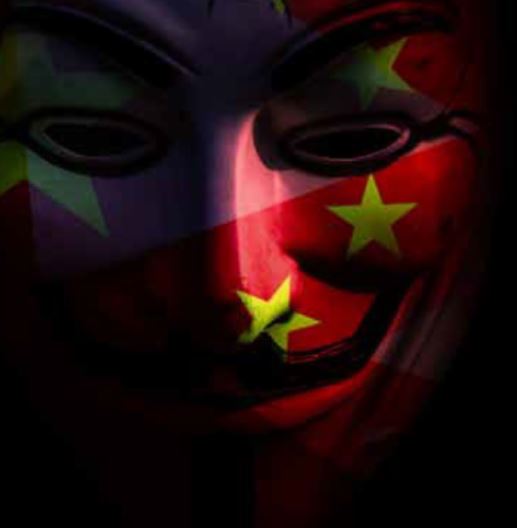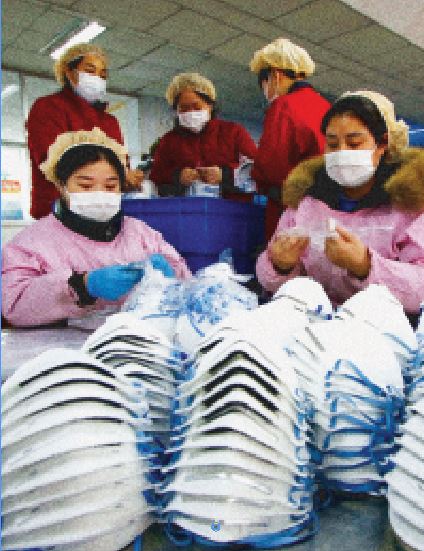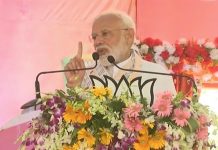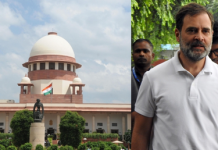 Was coronavirus a sinister design as life is almost back to normal in much of China. Shops, restaurants, bars, and offices are open for business. Manufacturing activity is picking up. Factories are up and running. Naturally there is a question mark as to how the virus spread from Wuhan in China and has been controlled so fast.
Was coronavirus a sinister design as life is almost back to normal in much of China. Shops, restaurants, bars, and offices are open for business. Manufacturing activity is picking up. Factories are up and running. Naturally there is a question mark as to how the virus spread from Wuhan in China and has been controlled so fast.
 Social media is agog with comments that suggest that China first put the world into ICU and is now supplying them ventilators and masks. One can see in China, the traffic is once again jamming the highways of major cities. A good majority of China’s workforce is back on the job while in developed economies, they are still fighting it out the coronavirus and in countries like India, the migrant labourers are making a bee line for their villages, endangering their and others lives.
Social media is agog with comments that suggest that China first put the world into ICU and is now supplying them ventilators and masks. One can see in China, the traffic is once again jamming the highways of major cities. A good majority of China’s workforce is back on the job while in developed economies, they are still fighting it out the coronavirus and in countries like India, the migrant labourers are making a bee line for their villages, endangering their and others lives.
China has done what few believed was possible: Restrictions have been lifted. Businesses resumed and in a few weeks from hence, most business activities will be resumed. At a time when major countries are struggling to check coronavirus, China has again made a head start.
BMW resumes work in China
 Even foreign companies in China are back in operation. BMW has resumed production once again. Nearly 20,000 employees of the BMW Brilliance factories in the northeastern Chinese city of Shenyang have returned to work. And the joint venture says it will fully resume normal production capacity in the near future. Shenyang has the BMW group’s largest overseas production base.
Even foreign companies in China are back in operation. BMW has resumed production once again. Nearly 20,000 employees of the BMW Brilliance factories in the northeastern Chinese city of Shenyang have returned to work. And the joint venture says it will fully resume normal production capacity in the near future. Shenyang has the BMW group’s largest overseas production base.
Reportedly, the CEO of BMW brilliance, Dr. Johann Wieland, wrote a letter to expresses thanks to the Shenyang municipal government. He believed that the company can respond quickly to changes in the market and will develop plans based on the actual situation to minimize the impact of the outbreaks on production, which thanks to their flexible production system and the support from government at all levels. And the CEO was confident to successfully complete the annual production, sales targets and construction of major projects.
Share up 417 per cent
Dawn Polymer share price has shot up 417 per cent since the outbreak of coronavirus. Making melt-blown fabrics — the unique material used in surgical masks — has been like printing money for Yu Xiaoning since the outbreak of coronavirus in January. The public health crisis that has spread from China to Europe and the US has led to a global shortage of surgical masks as governments seek to protect health workers, and people everywhere try to prevent contagion.
It has also created a surge in demand for the polymer-based fabrics used in the protective coverings. With an estimated market share of 40 per cent for the specialty fabrics used in masks in China, shares in Shenzhen-listed Dawn Polymer soared by 417 per cent since January 20. There are unconfirmed reports that China is in the process of taking over or buying stake in many overseas companies when these companies are in financial strain.
Trump’s tweet
 The natural corollary is: Can China keep it that way. There have been different conspiracy theories going around including that China developed this virus in a lab to use it as a biological warfare. A fuming US President Donald Trump tweeted describing the coronavirus – which causes the disease Covid-19 — as the “Chinese virus”.
The natural corollary is: Can China keep it that way. There have been different conspiracy theories going around including that China developed this virus in a lab to use it as a biological warfare. A fuming US President Donald Trump tweeted describing the coronavirus – which causes the disease Covid-19 — as the “Chinese virus”.
The World Health Organization (WHO) quickly warned against linking the virus to any particular area or group, due to the risk of stigmatisation. However, a number of US administration officials have referred to it as the Chinese virus. Meanwhile, Pompeo has repeatedly referred to the “Wuhan virus”. Geng Shuang, a spokesman for the Chinese foreign ministry, said the tweet amounted to “stigmatisation of China”. China’s official news agency, Xinhua, said Trump’s language was “racist and xenophobic” and revealed “politicians’ irresponsibility and incompetence”, risking increasing fears over the virus.
What a miracle China did-bring a blazing epidemic of a respiratory virus to a sudden virtual standstill. On March 18, the country reported zero locally transmitted cases of coronavirus or Covid-19 for the first time. Since then, only six of such infections have been reported, only one of them in Wuhan. Though Wuhan, where the coronavirus pandemic originated, is lagging, as is the rest of Hubei province — but even there, the lockdown is set to ne lifted soon.
For the time being, we shall not discuss conspiracy theories, but only the facts. The first fact is that while most of the world suffered and coronavirus reached even the remotest areas, in China, its major cities were completely insulated.
Shanghai, Beijing remain unscathed
For instance, Shanghai that has a population of about 2.5 crores had only 468 cases and 5 deaths. Beijing has a population of 2.15 crores but had only 500 cases of coronavirus and 8 deaths. The two cities are among the most populated cities in the world. Little doubt that the financial hub of China is still unscathed.
Public health officials worldwide are watching closely. Dennis Normile writing for Science Journal quoted epidemiologist Keiji Fukuda of the University of Hong Kong (HKU), “China is addressing an issue every country and location in the world will eventually face: how to normalize and restore societal activities, while at the same time minimizing disease-related dangers from the outbreak”.
New infections now mostly come from outside: More than 500 cases have been confirmed in incoming air passengers since March 18. Now China has banned virtually all foreigners from entering the country and required all returning Chinese to be quarantined for 2 weeks, whether coming by air or over land.
China is now open to tourists from within China. Foreigners are not being permitted in China to enter as they might bring back coronavirus. But the way activity has picked up, it seems that in few weeks life will be back to normal. Face masks are ubiquitous. People keep their distance in public and at work and millions still continue to work from home. However, reports suggest that close to 10,000 units are back to manufacturing. To guard against flare-ups, investigators trace and quarantine close contacts of every newly confirmed Covid-19 cases. In another precaution, everyone visiting fever clinics in Beijing and other major cities is now tested for the virus. And many provinces check the health status of migrant workers and others crossing their borders.
The new travel ban — which the government implemented even though it strenuously objected when the United States banned visitors from China in January — addresses the other main risk: reintroduction of the virus from the rest of the world. Flights into China have also been severely curtailed. Chinese citizens who arrive undergo strict screening en route and upon arrival and go into quarantine for 2 weeks.
Officials are relaxing restrictions very slowly and methodically. Many restaurants at first reopened with shortened hours and for a limited number of customers; now, doors are open to all. Primary and secondary schools in several provinces have reopened, but only in communities free of the disease, and schools must check students’ temperatures and watch for symptoms. Universities, where students from around the country mix, remain closed, with classes taught online. Events that draw crowds are still banned or discouraged. Live music venues and gyms in many cities remain closed. There are temperature checks at subway entrances and factory gates.
China’s strategy “seems to have been effective thus far in preventing a resurgence,” says Benjamin Anderson, an epidemiologist at Duke Kunshan University. For China much is at stake. Economists predict China’s gross domestic product may shrink 10 per cent in the first quarter of this year, the worst contraction since 1976. With Europe and the United States wrestling with their own epidemics, demand for China’s manufactured goods has collapsed — aside from masks and medical equipment and supplies.
Global economy in tailspin
The spread of the disease caused by the virus, Covid-19, has sent financial markets into a tailspin despite some of the biggest emergency stimulus measures since the global financial crisis announced by dozens of central banks across Europe, the Americas, Asia and Australia. The panic was clear in stocks, bonds, gold and commodity prices, underlining expectations of severe economic damage from the outbreak. Forecasts for 2020 global GDP ranged from -2.0 per cent to +2.7 per cent.
Although India is considered the least vulnerable among Asian countries, the spillover of a global slowdown is bound to have an impact on it. The lockdown is causing significant disruption across multiple sectors, including manufacturing, oil, financial, among others, says a report. According to Dun & Bradstreet’s latest Economy Forecast, the probability of countries entering into recession and companies going bankrupt has increased and India is not likely to “remain decoupled” from the global meltdown. Moody’s Investors Service, on March 27, sharply slashed its projection for India’s GDP growth in calendar year 2020 from 5.3 per cent to 2.5 per cent. The markdown was the second in 10 days and came after prime minister Narendra Modi announced the 21-day lockdown.
In its Global Macro Outlook 2020-21, Moody’s cited severe liquidity constraints in India’s banking and non-banking sectors as a hindrance to growth. Rating agencies, both global and domestic, are unanimous that the Covid-19 pandemic will be an economic tsunami for India. Even though the country may not slip into a recession, unlike the Eurozone, the US, or Asia-Pacific that have stronger trade ties to China, analysts believe the impact on India’s GDP growth will be significant. India is currently in the midst of a 21-day lockdown, that began on March 25, to contain the spread of the coronavirus. The fallout of the move will spill over to financial year 2021, which begins on April 1. On March 26, finance minister Nirmala Sitharaman announced a $23 billion package aimed at cushioning the disruption. India’s central bank joined the fight a day later with sharp interest rate cuts and a slew of unconventional measures aimed at making credit available to beleaguered businesses. In India, GDP growth is already at a decadal low and any further dent in economic output will bring more pain to workers who have seen their wages erode in
recent times.
Seizing opportunity
 The Chinese strategy is aimed at buying time until a vaccine or till drugs are available, says George Gao, Director of the China CDC. It is now manufacturing ventilators, face masks and other equipment to be used to check spread of coronavirus. An AFP report from Beijing also confirmed that as the coronavirus pandemic that originated in a central Chinese city went global, thousands of factories in China nimbly turned to a new and very profitable market – face masks for export. At the height of China’s outbreak in early February, Guan Xunze’s company created a new mask factory in just 11 days.
The Chinese strategy is aimed at buying time until a vaccine or till drugs are available, says George Gao, Director of the China CDC. It is now manufacturing ventilators, face masks and other equipment to be used to check spread of coronavirus. An AFP report from Beijing also confirmed that as the coronavirus pandemic that originated in a central Chinese city went global, thousands of factories in China nimbly turned to a new and very profitable market – face masks for export. At the height of China’s outbreak in early February, Guan Xunze’s company created a new mask factory in just 11 days.
The factory, with five production lines in north-eastern China, made the much-needed N95 face masks, which were in huge demand as infection numbers surged. As cases in the country dwindled, the 34-year-old — who was previously in pharmaceuticals — is now profiting from new markets and exporting masks to Italy, where the death toll has overtaken that of China.
In the first two months of the year, a staggering 8,950 new manufacturers started producing masks in China, according to business data platform Tianyancha – racing to fill the huge gap in demand. But after the virus epi centre of Hubei province was placed on lockdown and the initial frenzy began to die down in China, virus outbreaks emerged in new hot spots elsewhere in the world. As globally more than 400,000 have been infected with the deadly coronavirus, and demand for protective equipment is still soaring as nations across the globe battle the outbreak.
“A mask machine is a real cash printer,” said Shi Xinghui, sales manager of an N95 mask machine company in Dongguan city, south-eastern Guangdong province. “The profit of a mask now is at least several cents compared to less than one in the past. Printing 60,000 or 70,000 masks a day is equivalent to printing money.”
Qi Guangtu has put more than 50 million yuan (S$10 million) into his factory producing mask-making machines in the southern industrial hub of Dongguan. It has been in 24-hour continuous production since Jan 25 — two days after the dramatic lockdown of Wuhan, where the virus first emerged. “Cost recovery is certainly not a problem,” he said, adding that 70 sets of equipment have been sold for more than 500,000 yuan each. He has more than 200 additional orders in hand, worth over 100 million yuan. “The machines pay for themselves in 15 days,” said Qi, saying the investment is worth it for
his clients.
Manufacturer You Lixin had never set foot in a mask factory before. But as the market soared and he saw the opportunity, it took him just 10 days from first deciding to enter the industry to delivering automated machines capable of producing masks. “I slept two or three hours a day, so did my clients,” he said.
You’s clients also slept in his plant, waiting desperately to collect their new machinery. Some of them are garment factory owners in Wenzhou, eastern Zhejiang province, who had switched to producing face masks. “They were facing orders they had insufficient capacity to deliver, and they couldn’t make the deliveries,” You said. “The panic intensified as the crisis accelerated at that time.” The high levels of mask production has dramatically pushed up prices for raw materials.
According to Guan, the price of fabric has risen astronomically — from 10,000 yuan to 480,000 yuan per tonne. Producer Liao Biao struggled to bring back the components of mask machine piece by piece from outside Hunan province in late January, with the cross province border closed. Finally, to get an expert tester for the mask machines, Liao paid more than 10 times the normal price. “Investment is blind now,” You said.
But despite the rising costs of production, the profits still make the industry appealing. According to China’s official figures, China’s daily mask production has passed 116 million now, with many meeting overseas demand.
Guan has already delivered one million masks to Italy, while Shi currently has more than 200 orders from South Korea and countries in the European Union. “Dongguan remains the world’s factory,” said Shi. “The first peak of orders was during the middle of February. Now there is a second wave because of the pandemic.” Liao is also seeking to export his masks to Europe and Canada.
“The demand for masks has been alleviated at home — now we can have some surplus to support other countries,” he said. “We are willing to help others.” And Guan is optimistic about the future of the industry beyond the outbreak. “Most people will have the habit of wearing a mask after this outbreak,” he said.
Book in eye of storm
Why the needle of suspicion points to China is a book “Unrestricted Warfare” written by two colonels in the People’s Liberation Army, Qiao Liang and Wang Xiangsui. Its primary concern is how China can defeat a technologically superior opponent through a variety of means. Rather than focusing on direct military confrontation, this book instead examines a variety of other means. The book was then published in English by a Panamanian publisher with the subtitle “China’s Master Plan to Destroy America” with a picture of the burning World Trade Centre on its cover. The book was not a blueprint for a “dirty war” against the West but a call for innovative thinking on future warfare.
Tehelka story in March “Is coronavirus part of Chinese biological warfare?” pointed to a sinister design. The story quoted extensively from a journal on Geopolitical and International Relations, “Great Game India” published an article by Tyler Durden raising a question if China stole coronavirus from Canada to weaponize it? The Great Game India claimed that its investigation had linked the agents to Chinese Biological Warfare Program from where the virus is suspected to leak causing the Wuhan Coronavirus outbreak.
It said that last year a mysterious shipment was caught smuggling Coronavirus from Canada. It was traced to Chinese agents working at a Canadian lab. Its story goes like this. On June 13, 2012 a 60-year-old Saudi man was admitted to a private hospital in Jeddah, Saudi Arabia, with a 7-day history of fever, cough, expectoration, and shortness of breath. He had no history of cardiopulmonary or renal disease, was receiving no long-term medications, and did not smoke.
Egyptian virologist Dr. Ali Mohamed Zaki isolated and identified a previously unknown coronavirus from his lungs. After routine diagnostics failed to identify the causative agent, Zaki contacted Ron Fouchier, a leading virologist at the Erasmus Medical Center (EMC) in Rotterdam, the Netherlands, for advice. Fouchier sequenced the virus from a sample sent by Zaki. Fouchier used a broad-spectrum “pan-coronavirus” real-time polymerase chain reaction (RT-PCR) method to test for distinguishing features of a number of known coronaviruses known to infect humans.
This coronavirus sample was acquired by Scientific Director Dr. Frank Plummer of Canada’s National Microbiology Laboratory (NML) in Winnipeg directly from Fouchier, who received it from Zaki. The Great Game India alleges that Chinese agents allegedly stole this virus from the Canadian lab. It further alleges that coronavirus arrived at Canada’s NML Winnipeg facility on May 4, 2013 from the Dutch lab. The Canadian lab grew up stocks of the virus and used it to assess diagnostic tests being used in Canada. Winnipeg scientists worked to see which animal species can be infected with the new virus.
Biological Espionage
In March 2019, in mysterious event a shipment of exceptionally virulent viruses from Canada’s NML ended up in China. Scientists from NML had reportedly said the highly lethal viruses were a potential bio-weapon. Following investigation, the incident was traced to Chinese agents working at NML. The NML is Canada’s only level-4 facility and one of only a few in North America equipped to handle the world’s deadliest diseases, including Ebola, SARS, Coronavirus, etc.
The NML scientist who was escorted out of the Canadian lab along with her husband, another biologist, and members of her research team is alleged to be a Chinese Bio-Warfare agent. The agent was studying powerful viruses in Canada’s NML. The couple is allegedly responsible for infiltrating Canada’s NML with many Chinese agents as students from a range of Chinese scientific facilities directly tied to China’s Biological Warfare Programme including Wuhan Institute of Virology, Chinese Academy of Sciences, Hubei.
The Canadian investigation is still going on and questions remain whether previous shipments to China of other viruses or other essential preparations, took place from 2006 to 2018, one way or another. The alleged agents aka scientist allegedly made at least five trips over the school year 2017-18 to the above-mentioned Wuhan National Biosafety Laboratory of the Chinese Academy of Sciences. Coincidentally, the Wuhan National Biosafety Laboratory is located only 20 miles away from the Huanan Seafood Market, which is the epicenter of the Coronavirus outbreak dubbed the Wuhan Coronavirus.
The Wuhan National Biosafety Laboratory is housed at the Chinese military facility Wuhan Institute of Virology linked to China’s Biologi9cal Warfare Programme. The Wuhan institute has studied coronaviruses in the past; including the strain that causes Severe Acute Respiratory Syndrome, or SARS, H5N1 influenza virus, Japanese encephalitis, and dengue. Researchers at the institute also studied the germ that causes anthrax — a biological agent once developed in Russia.
China’s Biological Warfare Programme is believed to be in an advanced stage that includes research and development, production and weaponization capabilities. Its current inventory is believed to include the full range of traditional chemical and biological agents with a wide variety of delivery systems including artillery rockets, aerial bombs, sprayers, and short-range ballistic missiles. In fact, China’s national strategy of military-civil fusion has highlighted biology as a priority, and the People’s Liberation Army – PLA could be at the forefront of expanding and exploiting this knowledge.
The PLA is pursuing military applications for biology and looking into promising intersections with other disciplines, including brain science, supercomputing, and artificial intelligence. Since 2016, the Central Military Commission has funded projects on military brain science, advanced biomimetic systems, biological and biomimetic materials, human performance enhancement, and “new concept” biotechnology. Strategists who talk about potential “genetic weapons” and the possibility of a “bloodless victory” guide Chinese military’s interest in biology as an emerging domain of warfare. Till the Canadian investigation is complete about theft and shipments of viruses to China, the mystery and questions as to how coronavirus entered China would remain.
Fear of second corona wave
 However, though China has kick started economic activity, the scientists fear that there could be second coronavirus wave as with China’s lockdowns ease. For the first time in months, the Chinese province of Hubei, where the coronavirus first emerged, is getting attention for a good reason. Covid-19 cases there have dropped to practically zero, and last week authorities lifted travel restrictions in and out of the province, some 60 days after much of it was dramatically locked down. Now scientists — and the rest of the world — are watching closely to see whether easing the intense measures to keep people apart results in an emergence of new cases.
However, though China has kick started economic activity, the scientists fear that there could be second coronavirus wave as with China’s lockdowns ease. For the first time in months, the Chinese province of Hubei, where the coronavirus first emerged, is getting attention for a good reason. Covid-19 cases there have dropped to practically zero, and last week authorities lifted travel restrictions in and out of the province, some 60 days after much of it was dramatically locked down. Now scientists — and the rest of the world — are watching closely to see whether easing the intense measures to keep people apart results in an emergence of new cases.
In Nature Research Journal “Nature” David Cyraonski on March 30 observed that an early analysis suggests that, so far, these fears have not come to pass. “It’s time to relax the lockdown, but we need to be alert for a potential second wave of infections,” says Ben Cowling, an epidemiologist at the University of Hong Kong, who will be following the situation in China. If a second wave comes, Cowling would expect to see it emerge by the end of April.
How things unfold in Hubei — and across China — will be relevant to many European nations and some US states that have restricted travel inside their borders, closed most businesses, schools and universities and told people to stay at home, in an attempt to halt the pathogen’s spread. The modeling of the UK outbreak suggests that the country’s social distancing measures, including school and university closures, might be needed for large parts of the next two years to keep the proportion of people with severe Covid-19 infections in hospital at manageable levels.
But if China can show that it can lift its lockdown without a significant re-appearance of Covid-19, it might be possible that such protracted restrictions won’t be necessary. Chinese provinces will now use extensive testing and contact tracing to pinpoint new infections, and will maintain some social-distancing practices to prevent a resurgence. The country has also closed its borders to everyone but citizens to prevent cases from being imported. Returning residents will be quarantined for 14 days.
But some researchers say that the situation in China is different because its government acted aggressively, using social-distancing measures to slow down the spread and extensive testing and isolating of infected people to stamp out potential transmission sources. This strategy helped the country contain the outbreak. But other nations, such as Italy and Spain, have focused mainly on slowing the virus — through social distancing — without intensive testing and contact tracing. They will face more challenges when trying to return to life before the pandemic, says Cowling.
And yet, the risk of new outbreaks in China is high given the ease with which the virus passes between people, and the possibility that some infections still linger undetected, says Gabriel Leung, an infectious-disease researcher at the University of Hong Kong. It’s possible that one lockdown might not be enough, and severe efforts to suppress the virus might be needed again, he says. “The tension between health, protecting the economy and emotional well-being will vex every government for the foreseeable future.”
Restrictions ease
 Life in Hubei — home to roughly 60 million people — hasn’t returned to normal yet, but people are slowly leaving their homes and returning to work, and factories are reopening. Universities, schools and child-care centres remain closed pending “a scientific assessment of the epidemic control situation”, say government authorities.
Life in Hubei — home to roughly 60 million people — hasn’t returned to normal yet, but people are slowly leaving their homes and returning to work, and factories are reopening. Universities, schools and child-care centres remain closed pending “a scientific assessment of the epidemic control situation”, say government authorities.
And travel in and out of the provincial capital, Wuhan, remains restricted until 8 April. Until then, people will need to be tested for the virus to come and go. Since 18 March, there has been only one new case reported in Hubei. A UK team has modelled whether the increasing movement following the easing of travel curbs in six Chinese provinces with the highest number of Covid-19 cases resulted in a surge of new infections. In these provinces — Hubei, Beijing, Guangdong, Henan, Hunan and Zhejiang — the lockdowns helped to reduce new Covid-19 cases to near zero.
The team, led by infectious-disease researchers Neil Ferguson and Steven Riley at Imperial College London, found that as movement and economic activity in these regions increased in late February for all provinces except Hubei, the number of new infections stayed near zero. As activity restarted in Hubei in March, the numbers of new cases remained low. The analysis concludes that after containing the virus with the severe lockdowns, “China has successfully exited their stringent social-distancing policy to some degree.”
“So far, so good,” says Andrew Tatem, an emerging-disease researcher at the University of Southampton, UK. But the findings must be approached with some caution, he adds. The movement and economic activity levels in the six regions that the group measured were only half of what they were before the outbreak, except in Zhejiang province, where it appears to have matched pre-pandemic levels. There might also be a lag between the increase in activity and reports of new cases.
The virus would have difficulty reestablishing itself in the community if a significant portion of people, between 50 per cent and 70 per cent, were infected and are now immune, says Leung. But he notes that even in Wuhan — which accounted for more than half China’s 81,000 cases — the number of those people infected and are now immune to the disease is probably less than 10 per cent — which means there are lots of people still vulnerable to infection. A vaccine would increase the percentage of immune people, but no vaccines are expected for at least a year. “These numbers don’t allow a sigh of relief,” he says.
To see the risk of easing these measures, “You only have to look across to Hong Kong to see what’s happened there with a resurgence,” says Tatem. Hong Kong, as well as Singapore and Taiwan, contained the initial spread of the coronavirus with intensive testing and contract tracing.
But over the last week, all three regions have seen a jump in new infections. Most were in travellers from abroad, but some local transmission has been detected. All three regions have now temporarily banned international visitors and are making returning residents undergo a two-week quarantine.
Containment measures should be relaxed “gradually and with ultra-caution and very close monitoring and surveillance”, says Tatem.
Test and trace
China is still implementing extensive Covid-19 monitoring nationwide. Provinces issue all residents a QR code, a type of barcode containing information that is revealed when scanned, based on their health details and travel history.
If a person has remained in areas considered safe in China or has been quarantined and tested negative for the disease, they are assigned a ‘green status’ — the lowest risk — which allows them to cross provincial borders, enter hospitals and residential areas, and ride the subway and trains.
The measure not only keeps infected people from mingling with others, but if a new infection is detected, the government can track that person’s movements and pinpoint people they might have come in contact with. Cowling calls this an “advanced form of test and trace” that will allow China to identify as many infected people as possible as quickly as possible, and then isolate them.
The big question is whether that will be enough to stop a new outbreak. Cowling thinks other cities would have trouble if required to do the number of tests that Wuhan did, which at its peak reached about 10,000 tests per day. “There is a danger in focusing too much on testing and isolation,” he says, and adds that social-distancing measures will still be important.
Chinese cities seem to fear the dangers of loosening measures to keep people apart too soon. Museums and attractions in Shanghai, which have been open for the past 18 days, were shut again from today. Cinemas were also closed again. Although the city has relaxed some rules: people are no longer required to have a pass to leave residential compounds, and delivery people are able to enter these areas. The city also dropped the requirement to wear masks in some public areas — a practice police had previously enforced with drones or robots.
Most of the countries now facing raging outbreaks, including Italy, Spain and the United States, are relying on social-distancing policies and getting people to stay home. China implemented those measures, but it also built new hospitals and conducted extensive testing. Then, officials went door to door to check people’s temperatures. They tested anyone with a fever, and isolated positive cases. “The extra work allowed them to stop the virus,” says Cowling. “People are following China, but not in exactly the same way,” he says.
Bottom-line
If there’s one thing about coronavirus which has become a point of contention for various scientists, it’s the deepening mystery about how deadly the virus really is, how it originated and how China has been able to contain it while entire world is still struggling. The World Bank has forward that the economic fallout of the pandemic could drive large parts of east Asia into poverty.
The World Bank has said the pandemic was causing “an unprecedented global shock, which could bring growth to a halt and could increase poverty across the region”. While all this points to a war like situation, it is perhaps China that is up and running leading questions as to what China is upto and its role is shrouded in mystery?
letters@tehelka.com












